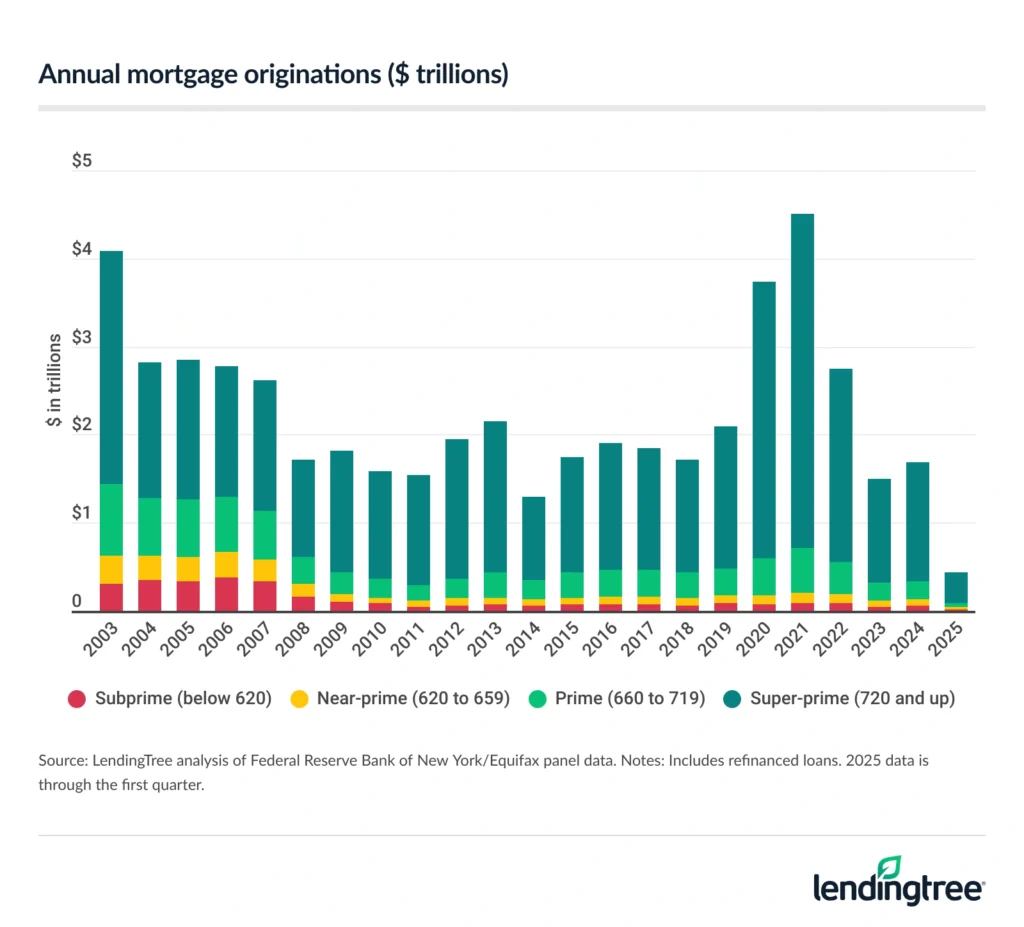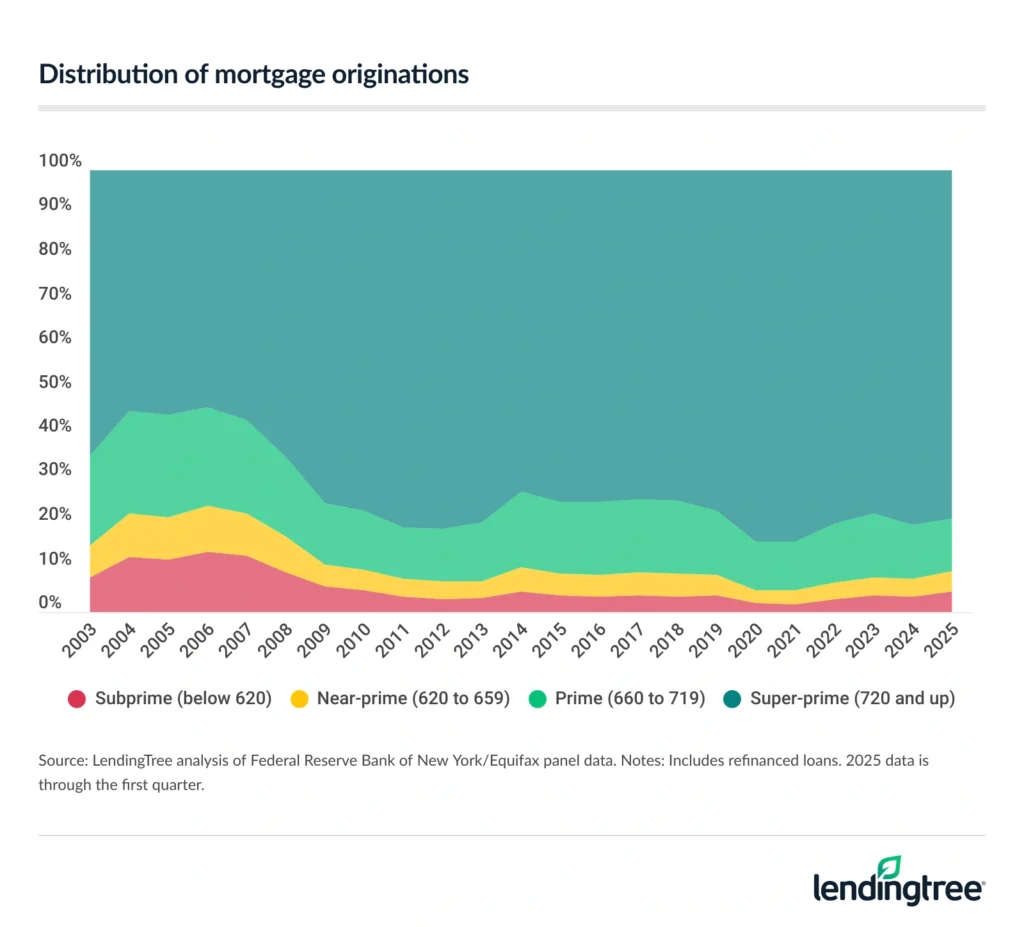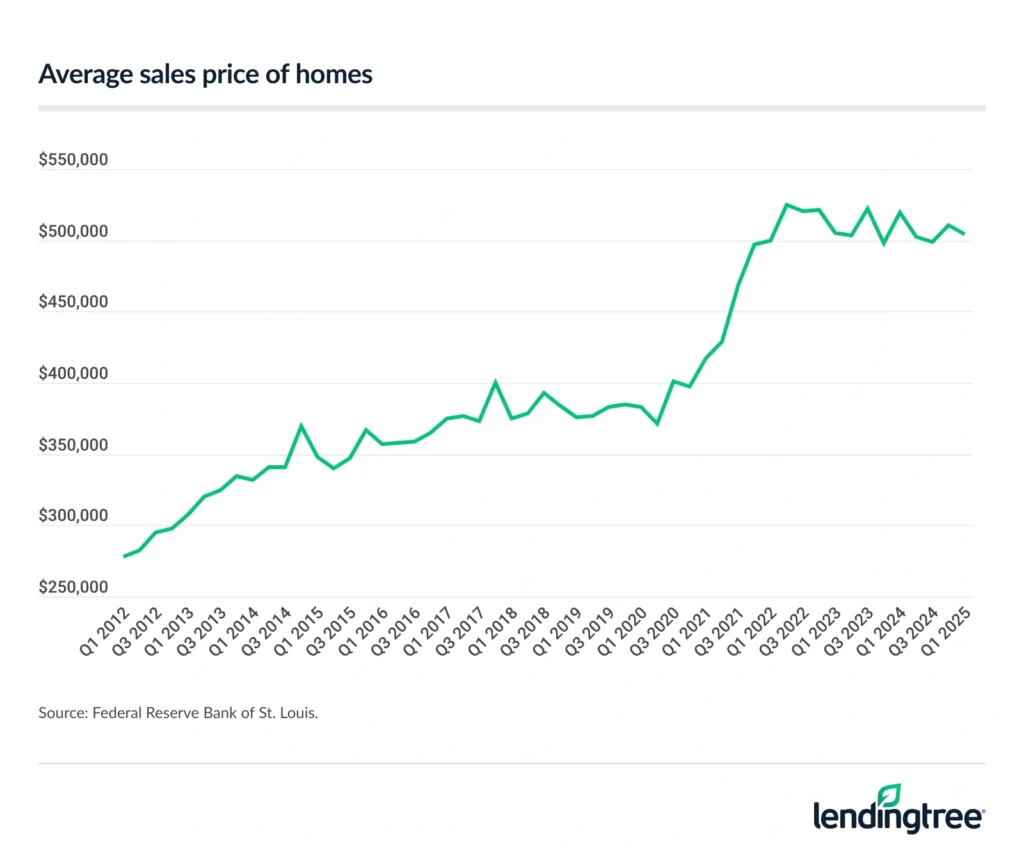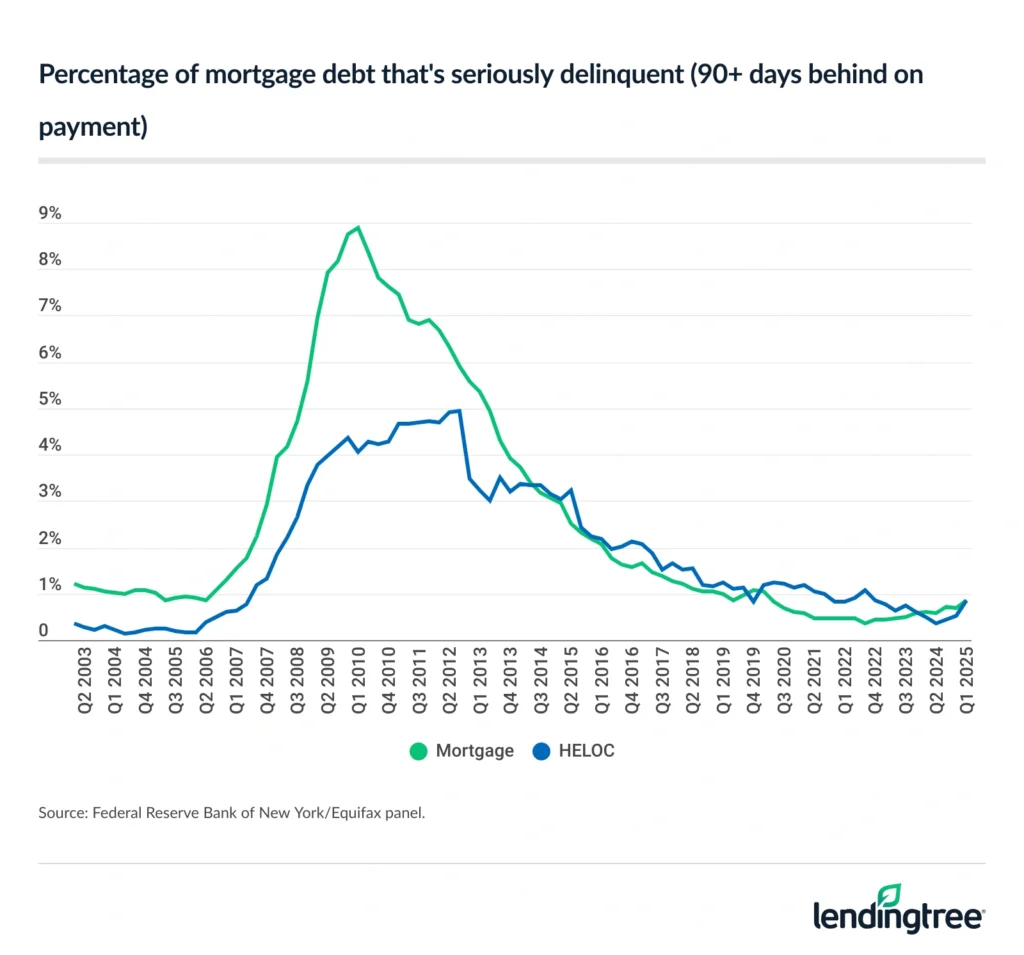Mortgage Statistics: 2025
The housing market has been sluggish over the past few years, hampered by steep mortgage rates and high home prices. Nonetheless, it remains an integral part of the economy.
Because of this, learning about what’s going on in the housing market can help shed light on the broader economy. For example, knowing that Americans collectively owe $12.80 trillion on their mortgages or that mortgage debt accounts for 70.3% of U.S. consumer debt provides insight into how and why Americans borrow money. In that same vein, seeing that only 0.86% of borrowers are seriously delinquent on their mortgages despite economic headwinds can assuage concerns about a potential collapse.
With all that in mind, LendingTree analyzed various data sources to create an overview of mortgage and housing market statistics. Read on to learn more about how much mortgage debt Americans have, how they manage and use that debt, and how the broader market appears to be faring in the face of an uncertain economic future.
Key mortgage statistics in 2025
- Americans owe $12.80 trillion on 85.78 million mortgages. That comes to an average of $149,266 per person with a mortgage on their credit report. Mortgages represent 70.3% of U.S. consumer debt.
- Additionally, Americans owe $402 billion on 13.14 million home equity lines of credit (HELOCs). That equates to an average of $30,594 per account. Outstanding HELOC debt represents 2.2% of U.S. consumer debt.
- The average interest rate for a 30-year, fixed-rate mortgage in 2024 was 6.72%. Rates ranged from a low of 6.08% the week ending Sept. 26 to a high of 7.22% the week ending May 2. So far in 2025, rates have ranged from a low of 6.62% the week ending April 10 to a high of 7.04% the week ending Jan. 16.
- Americans originated $430 billion in new mortgage debt in the first quarter of 2025. 78.9% was issued to super-prime borrowers with credit scores of at least 720, while 4.7% was issued to subprime borrowers with scores below 620.
- 0.86% of all mortgage debt in the U.S. was seriously delinquent in the first quarter of 2025, up from 0.70% in Q4 2024. While serious delinquencies grew recently, they’re still lower than in Q1 2020 at the start of the COVID-19 pandemic.
- In the first quarter of 2025, there were 61,660 foreclosures, a 49.6% increase from the previous quarter. In 2024, there were 174,100 consumers in the U.S. with a new foreclosure on their credit report. While this figure was up from 150,820 in 2023, it remained significantly lower than the 1,755,860 consumers who experienced new foreclosures in 2008 when the housing market crashed in the wake of the Great Recession.
- In Q1 2025, only 2.1% of mortgaged properties were “underwater.” This figure is up slightly from 2.0% in Q4 2024 and far below a record high of 26.0% in 2009.
- Through the first quarter of 2025, American households held $34.5 trillion, or 72.0% of the total value of residential real estate assets in the U.S., in real estate equity. That’s an increase of $600 billion from Q1 2024 and $4.7 trillion from Q1 2023, when American homeowners held $29.8 trillion in equity.
Outstanding mortgages
Spurred by a housing market frenzy born in the wake of record-low mortgage rates during the height of the COVID-19 pandemic, outstanding mortgage debt has grown by over $3.2 trillion since the end of 2019.
The massive increase can largely be attributed to two factors: an increase in the number of people with active mortgages and larger mortgage amounts.
Though mortgage rates have since climbed higher, many buyers were able to lock in record-low rates during the height of the pandemic. This allowed them to increase their purchase prices — or take advantage of cash-out refinances — while maintaining similar monthly payments to those they might have had before 2020.
Outstanding mortgages
| Quarter | Accounts* (millions) | Balances ($ trillions) | Avg. size per account |
|---|---|---|---|
| Q4 2014 | 81.43 | $8.17 | $100,332 |
| Q4 2015 | 80.61 | $8.25 | $102,332 |
| Q4 2016 | 79.90 | $8.48 | $106,133 |
| Q4 2017 | 79.99 | $8.88 | $111,039 |
| Q4 2018 | 79.35 | $9.12 | $114,984 |
| Q4 2019 | 80.94 | $9.56 | $118,075 |
| Q4 2020 | 80.60 | $10.04 | $124,603 |
| Q4 2021 | 80.96 | $10.93 | $135,005 |
| Q4 2022 | 83.42 | $11.92 | $142,927 |
| Q4 2023 | 84.17 | $12.25 | $145,539 |
| Q4 2024 | 85.10 | $12.61 | $148,120 |
| Q1 2025 | 85.78 | $12.80 | $149,266 |
Outstanding HELOCs
| Quarter | Accounts* (millions) | Balances ($ trillions) | Avg. size per account |
|---|---|---|---|
| Q4 2014 | 17.26 | $0.51 | $29,548 |
| Q4 2015 | 16.68 | $0.49 | $29,197 |
| Q4 2016 | 16.26 | $0.47 | $29,090 |
| Q4 2017 | 15.68 | $0.44 | $28,316 |
| Q4 2018 | 15.41 | $0.41 | $26,736 |
| Q4 2019 | 14.99 | $0.39 | $26,017 |
| Q4 2020 | 13.75 | $0.35 | $25,382 |
| Q4 2021 | 12.75 | $0.32 | $24,941 |
| Q4 2022 | 13.12 | $0.34 | $25,610 |
| Q4 2023 | 13.12 | $0.36 | $27,439 |
| Q4 2024 | 13.16 | $0.40 | $30,091 |
| Q1 2025 | 13.14 | $0.40 | $30,594 |
Mortgage rates
Mortgage interest rates for a 30-year fixed loan peaked at 18.63% in 1981. In fact, at no point in any year from 1979 through 1985 did average rates dip below 10.00%.
Over the past 50-plus years, rates dropped below 5.00% for the first time in 2009 after the Federal Reserve aggressively lowered target rates to combat the Great Recession of 2007 to 2009. Rates dipped below 4.00% for the first time in late 2011 and below 3.00% for the first time in 2020.
Average mortgage rates in the U.S. reached their lowest level in history (2.65%) during the first week of 2021. But they quickly rebounded, climbing in 2022 to their highest weekly point since 2002. While they ebbed and flowed from 2022 to the present, reaching a high of 7.79% in 2023, they have yet to fall back below 6.00%.
Here’s a look at historic mortgage rates dating to 1972:
Historic interest rates for 30-year conventional mortgages
| Year | Annual weekly avg. | High | Low |
|---|---|---|---|
| 1972 | 7.38% | 7.46% | 7.23% |
| 1973 | 8.04% | 8.85% | 7.43% |
| 1974 | 9.19% | 10.03% | 8.40% |
| 1975 | 9.05% | 9.60% | 8.80% |
| 1976 | 8.87% | 9.10% | 8.70% |
| 1977 | 8.85% | 9.00% | 8.65% |
| 1978 | 9.64% | 10.38% | 8.98% |
| 1979 | 11.20% | 12.90% | 10.38% |
| 1980 | 13.74% | 16.35% | 12.18% |
| 1981 | 16.64% | 18.63% | 14.80% |
| 1982 | 16.04% | 17.66% | 13.57% |
| 1983 | 13.24% | 13.89% | 12.55% |
| 1984 | 13.88% | 14.68% | 13.14% |
| 1985 | 12.43% | 13.29% | 11.09% |
| 1986 | 10.19% | 10.99% | 9.29% |
| 1987 | 10.21% | 11.58% | 9.03% |
| 1988 | 10.34% | 10.77% | 9.84% |
| 1989 | 10.32% | 11.22% | 9.68% |
| 1990 | 10.13% | 10.67% | 9.56% |
| 1991 | 9.25% | 9.75% | 8.35% |
| 1992 | 8.39% | 9.03% | 7.84% |
| 1993 | 7.31% | 8.07% | 6.74% |
| 1994 | 8.38% | 9.25% | 6.97% |
| 1995 | 7.93% | 9.22% | 7.11% |
| 1996 | 7.81% | 8.42% | 6.94% |
| 1997 | 7.60% | 8.18% | 6.99% |
| 1998 | 6.94% | 7.22% | 6.49% |
| 1999 | 7.44% | 8.15% | 6.74% |
| 2000 | 8.05% | 8.64% | 7.13% |
| 2001 | 6.97% | 7.24% | 6.45% |
| 2002 | 6.54% | 7.18% | 5.93% |
| 2003 | 5.83% | 6.44% | 5.21% |
| 2004 | 5.84% | 6.34% | 5.38% |
| 2005 | 5.87% | 6.37% | 5.53% |
| 2006 | 6.41% | 6.80% | 6.10% |
| 2007 | 6.34% | 6.74% | 5.96% |
| 2008 | 6.03% | 6.63% | 5.10% |
| 2009 | 5.04% | 5.59% | 4.71% |
| 2010 | 4.69% | 5.21% | 4.17% |
| 2011 | 4.45% | 5.05% | 3.91% |
| 2012 | 3.66% | 4.08% | 3.31% |
| 2013 | 3.98% | 4.58% | 3.34% |
| 2014 | 4.17% | 4.53% | 3.80% |
| 2015 | 3.85% | 4.09% | 3.59% |
| 2016 | 3.65% | 4.32% | 3.41% |
| 2017 | 3.99% | 4.30% | 3.78% |
| 2018 | 4.54% | 4.94% | 3.95% |
| 2019 | 3.94% | 4.51% | 3.49% |
| 2020 | 3.11% | 3.72% | 2.66% |
| 2021 | 2.96% | 3.18% | 2.65% |
| 2022 | 5.34% | 7.08% | 3.22% |
| 2023 | 6.81% | 7.79% | 6.09% |
| 2024 | 6.72% | 7.22% | 6.08% |
| 2025 | 6.81% | 7.04% | 6.62% |
Mortgage originations
Mortgage originations dropped off dramatically as rates rose from their 2021 historic lows to their highest point in 20 years. In fact, mortgage originations totaled $2.75 trillion in 2022, compared with $4.51 trillion in 2021. Originations continued to drop in 2023 to $1.50 trillion. However, origination rose to $1.69 trillion in 2024 — a 12.9% increase from the previous year.
At $4.51 trillion, 2021 marked the largest annual origination volume in any year for which we have data. Historically low rates that year meant that borrowers could take out bigger loans for similar monthly payments, and it also drew many people to refinance their existing mortgages.
Origination volume was also elevated in the years leading up to the housing market crash and Great Recession of the late 2000s, with subprime borrowers with credit scores below 620 taking up an unusually large share of the new debt.
Subprime borrowing as a share of origination volume peaked in 2006 at 13.6%, while super-prime borrowers with scores of at least 720 held their smallest share that year (53.5%). In 2024, subprime borrowers accounted for 3.6% of all individuals who originated a mortgage. Super-prime borrowers, on the other hand, made up 80.3% of those who got a mortgage.
As of the first quarter of 2025, 78.9% was issued to super-prime borrowers, while 4.7% was issued to subprime borrowers.


Average sales price
The average purchase price for a home in the U.S. was $503,800 as of Q1 2025.
Driven largely by lower mortgage rates, home prices rose dramatically after the start of the pandemic. Despite initially dipping from an average of $383,000 in Q1 2020 to $371,100 in Q2 2020, prices climbed to a record high of $525,100 in Q2 2022 — an increase of $142,100, or 37.1%, from Q1 2020.
Prices have since decreased by $21,300 nationally but remain elevated and at or above highs in some areas.

Delinquencies and foreclosures
According to the Federal Reserve Bank of New York, 0.86% of all mortgage debt as of Q1 2025 was seriously delinquent by 90 days or more. Although this percentage increased compared to the same period last year, the rate of mortgage debt that’s seriously delinquent is still lower than it was before the pandemic.

Like serious delinquencies, foreclosures also remain rare, though they’re more common than during the height of the pandemic when they were at historic lows. In 2024, there were 174,100 new foreclosures reported on individuals’ credit reports, marking the highest number of new foreclosures since 2019.
Foreclosures in 2024 were still lower than in any year from 2003 (the earliest year for which LendingTree has data) through 2019. In the first quarter of 2025, there were 61,660 foreclosures, a 49.6% increase from the previous quarter, Q4 2024, when there were 41,220 foreclosures.
As discussed, 2021 saw a significant surge in the total volume of dollars originated as mortgage debt, with a historically high proportion of that going to super-prime borrowers who were able to lock in at or near record-low mortgage rates. For this reason, delinquencies and foreclosures haven’t dramatically increased compared to before the pandemic. And they’re unlikely to do so, even in the face of economic headwinds.
Number of new foreclosures
| Year | Foreclosures |
|---|---|
| 2012 | 451,340 |
| 2013 | 708,140 |
| 2014 | 495,620 |
| 2015 | 404,180 |
| 2016 | 339,200 |
| 2017 | 314,220 |
| 2018 | 284,360 |
| 2019 | 277,560 |
| 2020 | 129,000 |
| 2021 | 38,040 |
| 2022 | 122,140 |
| 2023 | 150,820 |
| 2024 | 174,100 |
| 2025 | 61,660 |
Sources
- Federal Reserve
- Federal Reserve Bank of New York/Equifax panel
- Federal Reserve Bank of St. Louis
- Cotality
View mortgage loan offers from up to 5 lenders in minutes
Read more
Average Down Payments on Homes Across 50 Largest US Metros Top $84,000 Updated August 31, 2021 A down payment on a home across the nation’s 50 largest metros averages $84,499 —…Read more
Homeownership Gender Gap: Single Women Own More Homes Than Single Men Updated January 20, 2020 A LendingTree analysis finds that single women who live by themselves are more likely than…Read more

